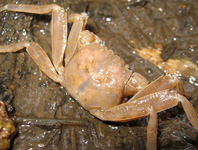Abstract
The parasitic copepod Lernaeenicus stromatei Gnanamuthu, 1953 infecting black pomfret, Parastromateus niger (Bloch) (Carangidae) is redescribed based on a neotype and additional fresh material obtained from hosts collected at different fish landing centers on the Chennai Coast (Tamil Nadu), Malabar Coast (Kerala), and from West Bengal, India. A female L. stromatei obtained from the Chennai Coast has been designated as a neotype and deposited in the National Zoological Collections of Zoological Survey of India (NZC-ZSI). Lernaeenicus stromatei can be identified based on the following features: A long and slender body; head anteriorly rounded, dorso-ventrally flattened and slightly longer than broad; presence of three posterior horns on the head, one median and two lateral, all sub-similar and apically rounded; and an anterior neck with an indistinct partition on the dorsal side, indicating thoracic segments, and a three-jointed antennule.
References
Aneesh, P.T. (2014) Studies on parasitic crustaceans infesting the fishes of Malabar Coast (Ph. D. thesis), Kannur University, Kerala, 147 pp.
Aneesh,P.T., Helna, A.K., Trilles, J.P. & Chandra, K. (2017) Occurrence and redescription of Anilocra leptosoma Bleeker, 1857 (Crustacea: Isopoda: Cymothoidae) parasitizing the clupeid fish Tenualosa toli (Valenciennes) from the Arabian Sea, India. Marine Biodiversity, 1–8. [published online]
https://doi.org/10.1007/s12526-017-0828-7Burmeister, H. (1835) Beschreibung einiger neuen oder weniger bekannten Schmarotzerkrebe, nebst allgemeinen Betrachtungen uber die Gruppe; welcher sie angehoren. Nova Acta Physico-Medica Academiae Caesareae Leopoldino- Carolinae Naturae Curiosorum (Acta der Kaiserlichen Leopoldinisch-Carolinischen Deutschen Akademie der Naturforscher), Halle, 17, 269–336, pls. XXIII + XXIV + XXIVA + XXV.
Castro Romero, R. (2014) Two new genera of pennellids (Copepoda, Siphonostomatoida): Propeniculus and Pseudopeniculus, each with a new combination, Propeniculus trichiuri (Gnanamuthu, 1951) and Pseudopeniculus asinus (Kabata & Wilkes, 1977). Crustaceana, 87, 551–569.
https://doi.org/10.1163/15685403-00003304Boxshall, G.A. & Halsey, S.H. (2004) An Introduction to Copepod Diversity. The Ray Society, London, 966 pp.
Froese, R. & Pauly, D. (2018) FishBase. Version 03/2018. Available from: http://www.fishbase.org/ (accessed 30 March 2018)
Gnanamuthu, C.P. (1953) Three Lernaeid copepods parasitic on South Indian fishes. Journal of Parasitology, 39, 14–21.
https://doi.org/10.2307/3274053Helna, A.K., Sudha, K., Aneesh, P.T., Piasecki, W. & Anilkumar, G. (2016) A case of persisting massive infection of Scomberomorus commerson, a commercially exploited scombrid fish, with Cybicola armatus (Copepoda: Siphonostomatoida: Pseudocycnidae). Acta parasitologica, 61 (4), 836–848.
https://doi.org/10.1515/ap-2016-0116Hogans, W.E. (2018) Functional morphology and structural variability in Lernaeenicus(Copepoda:Pennellidae) parasitic on teleost fishes on the Atlantic coast of North America. Comparative Parasitology, 85 (1), 13–26.
https://doi.org/10.1654/1525-2647-85.1.13Milne Edwards, H. (1840) Histoire naturelle des Crustace´scomprenant l‟anatomie, la physiologie et la classification de ces animaux. Librairie Encyclope´dique Roret, Paris, III + 605 pp.
Lesueur, C.A. (1824) On three new species of parasitic Vermes, belonging to the Linnæan genus Lernæa. Journal of the Academie of national Sciences of Philadelphia, 3 (10), 286–293, pl. 11.
Ohtsuka, S., Lindsay, D.J. & Izawa, K. (2018) A new genus and species of the family Pennellidae (Copepoda, Siphonostomatoida) infecting the Pacific viper Fish Chauliodus macouni. Parasite, 25, (6), 1–10.
Pillai, N.K. (1985) The Fauna of India. Copepod Parasites of Marine Fishes. In: The Fauna of India. Zoological Society of India, Calcutta, pp. 1–900.
Raja, K., Saravanakumar, A., Gopalakrishnan, A., Vijayakumar, R., Hwang, U.W. & Venmathi Maran, B.A. (2016) The genus Lernaeenicus Lesueur (Copepoda, Siphonostomatoida, Pennellidae) in India: a checklist with notes on its taxonomy and ecology. Zootaxa, 4174 (1), 192–211.
https://doi.org/10.11646/zootaxa.4174.1.14Walter, T.C. & Boxshall, G.A. (2018) World of Copepods database. Available from: http://www.marinespecies.org/copepoda (accessed 30 March 2018)
Wilson, C.B. (1932) The Copepods of the Woods Hole region Massachusetts. Smithsonian institution, United States National museum, Bulletin, 158, I–XIX + 1–635, 316 figs.
Yamaguti, S. (1963) Parasitic Copepoda and Branchiura of fishes.- Interscience Publishers, New York, 1104 pp., 333 pls.

